Professional pitchers are tasked with the responsibility of getting the best hitters in the world out. To do this, they rely on a mix of baseball pitches that differ in both velocity and movement.
Pitchers will use change in velocity (from pitch to pitch) to keep the hitter off balance and they will use late movement on pitches to miss the barrel of a bat. Every pitcher is different and will have his own combination of pitches.
In this article we will:
- Provide a list of all big-league baseball pitches
- Discuss professional pitching strategy
- Show illustrations of each pitch
- Explain how each pitch moves
- Discuss what type of pitches a professional pitcher will use
- Compare certain baseball pitches and how they differ
- Explain how you can identify pitches while watching on TV
Baseball Pitches List
In this section we will list the type of baseball pitches. Later, we will illustrate and explain each.
Types of Fastballs in Baseball
- Four seam
- Two Seam
- Cutter (also called “Cut Fastball”)
- Splitter (also called “Split” or “Split Fastball”)
Types of Breaking Balls in Baseball
- Curveball
- Slider
- Slurve
- Screwball
Types of Off-Speed Pitches in Baseball
- Straight Changeup
- Circle Changeup
- Forkball
- Knuckleball
Pitching Strategy Introduction
As we discussed earlier, to square up a baseball, a batter must be both 1) on balance with his swing and 2) on target with his swing. Correct timing allows for proper balance and on-target allows the hitter to match the strongest part of the bat (the barrel) to the ball.
When professional hitters are on balance and on target with their swings, they can drive the baseball a long ways. Therefore, pitchers will use changes in velocity and movement to not only keep hitters off balance, but also keep those hitters from hitting the baseball with the barrel of the bat.
This means a professional pitcher needs a variety of pitches (also called a ‘pitch mix’) that allow for drastic changes in velocity and variations in movement. This combination of velocity change and movement makes it very difficult for hitters to square up a baseball.
On the professional level, most all pitchers have fastballs that reach 90+ mph. Being able to throw a pitch 90+ mph is an asset when you then mix it with a breaking ball or off-speed pitch that is 70-80 mph.
That extreme change in velocity is very difficult to deal with, especially if the pitcher has quality mechanics – meaning that the release point and arm speed for both a fastball and an off-speed pitch are virtually the same. This means the hitter will likely have difficulty distinguishing between the two until it’s too late.
In the sections below, we will illustrate the common pitches used in professional baseball, then go through them one-by-one to explain how they work and why pitchers use them.
Baseball Pitches Illustrated and Explained
There are three main types of pitches in Major League Baseball:
- Fastballs
- Breaking Balls
- Off-Speed Pitches
Each type has multiple pitches that fit into its category. In the sections below we will illustrate and explain the different types of pitches that you may see at the professional level.
Fastballs
A fastball is considered to be a type of pitch that relies on its velocity to beat hitters. Although this is true for the fastest type of fastball (the 4-seam fastball) other fastball types will also rely on movement to trick hitters. Below is an illustration of the four fastballs and how they move.
**It is important to remember that location does not matter. For example, if a 2 seam fastball is thrown high or low or outside or inside, it is still a 2 seam fastball. These illustrations are intended to show movement.**
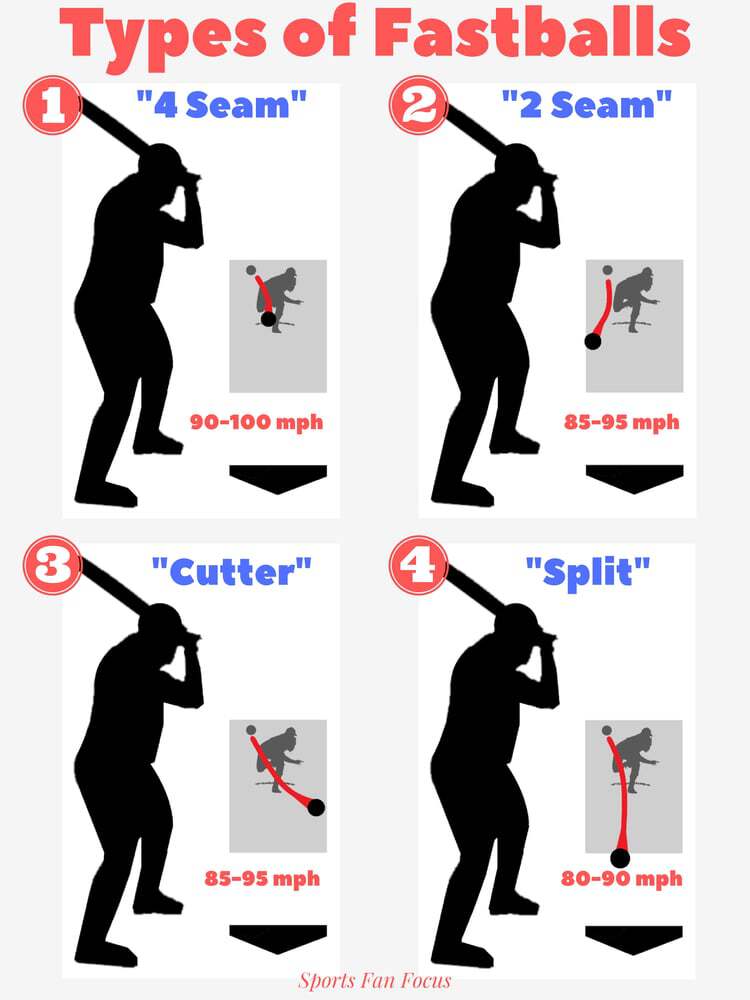
The four main types of fastballs that a pitcher may choose to throw are:
- 4 seam
- 2 seam
- Cutter
- Splitter
Some pitchers may choose to throw two or three of these variations of fastballs, while others only throw one.
“4 Seam” Fastball
- Velocity: 90-100mph
- Movement: Straightest movement of all fastballs.
- Video: Click here for examples of MLB’s best 4 seam fastballs
- Grip: Click here for how professional pitchers grip a 4 seam fastball
The “4 seam” fastball is considered to be the standard fastball, so much so that some people just refer to it as “fastball”. Its grip allows pitchers to put all the force through the center of the baseball, causing it to have extreme velocity, which is what makes this pitch effective.
Some professional pitchers can throw 4-seam fastballs at 100 mph or more (although the standard is more 92-97ish). As you can imagine, this is very difficult to hit. At this velocity (95+), it can be effective located anywhere around the strike zone (although pitchers always try to avoid the middle of the strike zone).
“4 seam” fastballs can be particularly effective when they are elevated at the top part of the strike zone, like this:
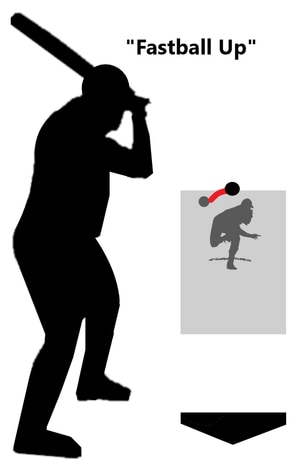
Professional pitchers will use fastballs up in the zone to trick hitters. From the batter’s perspective, the pitch is centered on the plate and elevated so it looks very hittable (hitters like baseball pitches up in the zone because you can get under the baseball and elevate it and drive it deep into the outfield). But because there is so much velocity on a fastball, most hitters don’t have the bat speed to catch up to a fastball that high up in the zone. So they swing at a pitch that looks good, but one that they can’t catch up to and hit.
Because of this, 4-seam fastballs up in the zone are very effective for professional pitchers. If a pitcher throws 95 mph or more with their 4-seam, as long as they miss the heart of the plate, all locations of a pitch that fast can be effective and difficult for professional hitters to handle.
Although pitchers want movement on their pitches, the “4 seam” fastball is usually the lone exception for two main reasons:
- Location – Straight baseball pitches are more reliable and easier to locate. Sometimes, pitchers must throw a strike. And if all of their pitches have late movement, that means they would have a difficult time locating a quality strike (like on the corner) when they absolutely needed to. Straight is easier to locate that something that cuts, curves or sinks etc. A fast, competitive 4-seam fastball allows a pitcher to throw a pitch they trust will locate (because it doesn’t move much), but because the velocity is so extreme (95+), they can still “win” with this pitch. Straight makes its location predictable (for both the hitter and batter) but the extreme velocity still makes it difficult for a batter to square up.
- Velocity – The straighter the pitch, the more velocity it has. The spin that generates movement also slows a pitch down a few miles per hour. If a pitcher uses a “4 seam” fastball, they generally want to throw it as hard as they can, so they will use a grip that allows them to put pressure evenly through the center of the baseball, which drives the baseball forward without favoring one side of the ball over the other, which eliminates side spin and subsequently, movement.
There are many ways to succeed as a big league pitcher, but the most common trait in successful professional pitchers is a quality fastball. Again, as we discussed above, the 4-seam fastball is the easiest pitch to locate. And location is super important for pitchers.
What a quality fastball allows a pitcher to do is if they fall behind in a count (for example 3-1) and they must throw a strike, it allows them to use a pitch they trust they can locate as a strike (because movement is minimal) but if it is a quality fastball (95+mph) they also can still beat a hitter with it.
Compare that with, for example, a curveball (which we will discuss in depth later). Curveballs trick hitters and are difficult to square up and hit. But the problem for pitchers is this: because it moves so much, it is difficult to consistently locate it right where they want it. So if they are behind in a count and need to throw a strike, it is risky to rely on a pitch that has a lot of movement.
Now, it is also important to understand that some professional pitchers are so good, that they can consistently locate even their pitches that have a lot of movement. This is what makes these pitchers the best of the best.
But many professional pitchers cannot locate consistently their pitches with the most movement. For these pitchers, the fastball is what they rely on. If they have a quality, hard fastball that they can consistently locate as a strike, they can throw it in counts where they must throw a strike, but because the pitch is so fast, they can still miss a bat with it.
Success as a big league pitcher is dependent on many things, but perhaps the most important is this: can they throw a pitch in the strike zone and still miss a bat? Sure, any professional pitcher could avoid contact by throwing balls out of the zone, but this would fail long term as a strategy because hitters would wise-up and take walks.
Eventually, pitchers must throw strikes, and the elite pitchers have such quality pitches, that they can throw pitches in the strike zone, and still miss bats and/or induce weak contact. Quality “4 seam” fastballs (95+mph) is one of the best baseball pitches for achieving this, because not only is it hard for the hitter to hit, but it is also reliable for the pitcher to locate. Those who are blessed with the arm talent that it takes to throw this hard can be elite professional pitchers because they can both attack the strike zone, and miss bats.
“2 Seam” Fastball
- Velocity: 85-95 mph
- Movement: Late arm-side break
- Video: Click here for examples of MLB’s best 2 seam fastballs.
- Grip: Click here for how professional pitchers grip a 2 seam fastball.
An effective “2 seam” fastball is considered to be one of the nastiest pitches in Major League Baseball. It can carry extreme velocity (up to 95ish mph) but also have late arm-side movement. A combination of elite velocity, like 95 mph, and late movement makes it very difficult for batters to square-up and drive.
The movement of a “2 seam” fastball will always be arm-side (in reference to the arm-side of the pitcher). So, for a right-handed pitcher, the ball with break to their right (the pitcher’s right), and for a left-handed pitcher, the ball will break to their left. Here is an illustration of arm-side movement for “2-seam” fastballs:
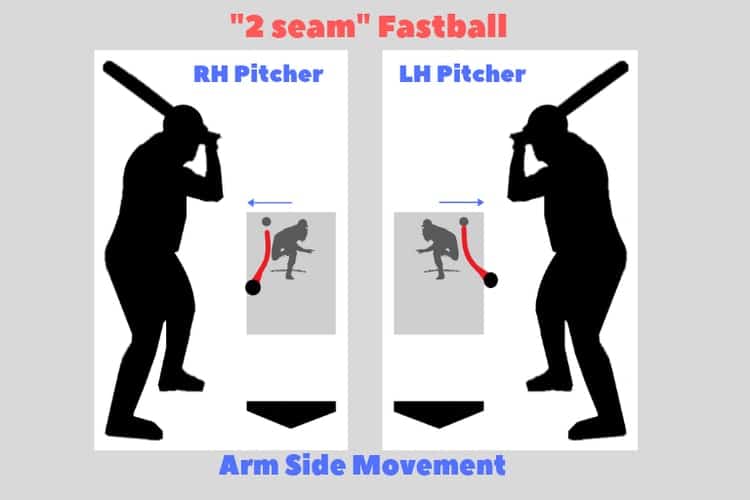
The late movement on “2 seam” fastballs can be the difference between a batter squaring up a baseball and hitting it with the barrel of the bat and the batter getting jammed and hitting a slow-roller to the pull side. Those two outcomes are very different, in that one is a win for the batter and the other is a win for the pitcher. Because of that, the effectiveness of a “2 seam” fastball often comes down to the quality of the pitch’s arm-side break.
One issue professional pitchers commonly have is getting opposite-handed hitters out consistently. For example, a right-handed pitcher may often struggle against left-handed hitters. The main reason for this is hitters on the opposite side of the plate from a pitcher’s throwing arm can see the release point easier (which makes it more comfortable), and the ball must travel farther to get in on their (the hitter’s) hands.
In the 2018 Major League Baseball season, right-handed pitchers league-wide held right-handed hitters to a .308 wOBA, but were less effective against left-handed hitters, who posted a .325 wOBA (wOBA = weighted on base average, a “catch-all” offensive statistic, read more here). I cite that statistic to again illustrate that right-handed pitchers will struggle, more commonly, against left-handed hitters.
Despite this, some right-handed pitchers are very effective versus left-handed hitters. One trait that many of those pitchers have is a quality 2- seam fastball that they use to neutralize left-handed hitters.
A right-handed pitcher can start a hard “2-seam” fastball right at the front hip of a left-handed batter, then see the late movement on the pitch draw the pitch back into the inside part of the strike zone.
This pitch, when executed correctly, is difficult for left-handed hitters to deal with because when the ball explodes out of the pitcher’s hand, it looks like it might hit them (the batter) in the hip or ribs or leg, and so their front side either freezes or flies open. And then when the pitch moves late, they’re not ready to swing and the pitch has effectively “locked them up”. Here is an illustration of how a right-handed pitcher will use the “2 seam” to neutralize left-handed batters:

Of course, a 2-seam fastball can also be very effective against a same-sided hitter because the pitch can start over the fat part of the plate, then draw back in with the late movement and jam the hitter as they swing.
As with any pitch in baseball, the later the movement, the better. When a pitch breaks early, the hitter sees it and adjusts the swing. When a ball moves late, the hands of the hitter are already committed, and the outcome of late movement is usually a missed bat or weak contact, both of which are wins for the pitcher.
Sinker vs 2 Seam Fastball
Some pitchers will refer to a 2-seam fastball as a “sinker”. This is due to the late sinking action that occurs when many pitchers throw this pitch.
It is important to remember that no two pitchers are exactly alike. Arm angles, release points, seam grips, height, arm strength, wrist movement, all these types of things will vary from pitcher to pitcher. This means that on any given pitch, one pitcher may get different movement than other pitchers, even if they are both attempting to throw the same pitch.
That is the case with “2 seam” fastballs. The pitch is gripped and released in a way that causes arm-side fade, but the exact amount will differ from pitcher to pitcher and is the sum of all the variable parts that make up a pitcher and a pitching motion.
For those pitchers who get extra sink (some times referred to as “heavy” sink) on the 2-seam fastball, they will often refer to their 2-seamer as a “sinker” due to this distinguishing heavy-sink characteristic. The grip for a sinker is often the same or very similar to regular 2-seam fastballs. Some pitchers may tweak it to try and get even more sinking action.
2 Seam vs 4 Seam Fastball
Although both can be very effective fastballs, these are two things that make these pitches different:
- Velocity – 4 seam fastballs are faster
- Movement – 2 seam fastballs have late arm-side movement, and 4 seam fastballs are generally straight.
Not all pitchers will throw both of these types of fastballs. Usually, what fastball a pitcher throws will come down to the quality of the pitch out of their hand. If they can generate extreme velocity, they will likely use a 4 seam fastball, but if they can get late, nasty break on a hard 2-seamer, they may choose to throw it. Some starting pitchers (because they face so many batters) may choose to use both over the course of a start, depending on the specific situation.
Cutter or ‘Cut Fastball’
- Velocity: 85-95 mph
- Movement: Late glove-side break
- Video: Click here for examples of MLB’s best cutters.
- Grip: Click here for how professional pitchers grip a cutter.
The cutter (also known as a “cut fastball”), when thrown effectively, is one of the most reliable big-league pitches. It carries hard velocity, with tight, late movement towards the pitcher’s glove side.
One reason that cutters are so reliable is the movement is so tight and late, that pitchers can still easily control the pitch. It doesn’t have loopy, diving action. It has a sharp, glove-side cut that occurs late in the pitch’s path. Both right-handed and left-handed pitchers will use this pitch effectively.
In modern baseball, this pitch has gained popularity due to the success that New York Yankee great Mariano Rivera had with his cutter. The cut fastball is a pitch, when thrown effectively, that is hard to square-up as a hitter even if you know its coming. The movement on the pitch is so late and so sudden, that it tricks the eyes into thinking the pitch will be in a different location than it is when it crosses the plate.
A cutter can be effective for pitchers to use against both right-handed and left-handed batters. If the pitcher is facing a same-side batter, they can use a cutter, like in this illustration, and start it at the batter’s hip then work it back late for a strike.
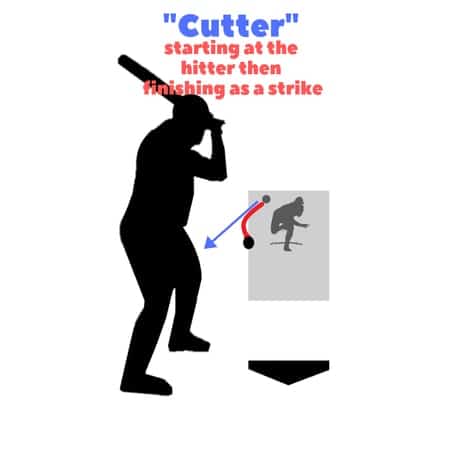
A pitcher can also use it effectively against an opposite-side hitter. For example, a right-handed pitcher can throw it to a left-handed batter and run the late movement down onto the hands of the hitter’s bat.
Cutters can be a pitcher’s best friend because the movement can be so late and so tight that it isn’t enough to completely miss a bat, but it is enough to move the ball away from the barrel and produce weak contact. One of the most underrated things for a pitcher is their ability to produce weak contact from a hitter. If they get weak contact, it saves on their pitch count and also produces consistent outs.
2 Seam Fastball vs Cutter
2 seam fastballs and cutters are very similar, except for the break of their movement. Both pitches are generally thrown by professional pitchers in the 85-95 mph range, but 2-seamers break toward the pitcher’s arm-side, while cutters break toward the pitcher’s glove-side. Here is an illustration:
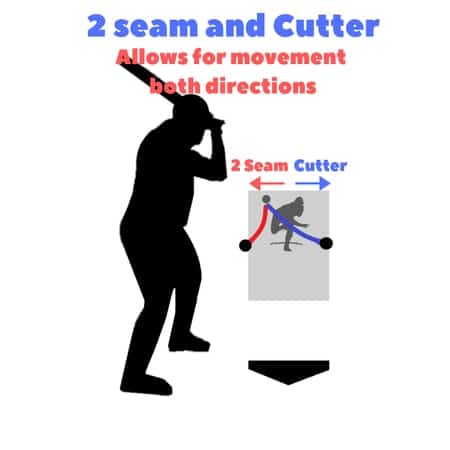
When a pitcher throws both a 2-seam fastball and a cutter, this allows them to move the ball both directions at a similar velocity. This makes it even harder on hitters if the pitcher has a repeatable delivery and release point, the ball starts on the same path, then (depending on pitch) it may break in or out. This creates a lot of guesswork on the part of the hitter.
Being able to move the fastball both directions also allows a pitcher to work away from a hitter’s strengths. For example, if a right-handed hitter does his most damage to baseball pitches on the outside part of the plate, a right-handed pitcher can use that 2-seamer to naturally work back inside on the hitter, to help avoid the hitter’s strengths.
Splitter or ‘Split Fastball’
- Velocity: 80-90 mph
- Movement: Late sinking action with possible arm-side break
- Video: Click here for examples of MLB’s best splitters.
- Grip: Click here for how professional pitchers grip a splitter.
Although a splitter is called a fastball, it functions more as an off-speed pitch. It is similar to a fastball in that the arm speed and release point for a splitter is the same as a normal fastball. The difference is the grip releases the force to the outer edges of the baseball, which causes the baseball to lose velocity and dive as it nears the plate.
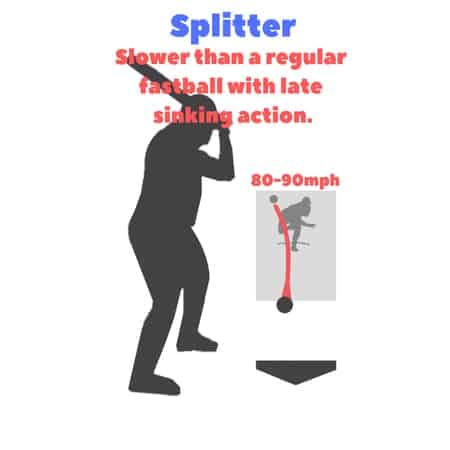
This late diving action is difficult for batters to deal with because when the ball is halfway to the plate, it looks like a fastball. So by the time a batter has fired their hands thinking they’ve got a fastball, when the splitter dives late, the batter is unable to adjust and either swings over the pitch, or hits the top half of the baseball.
Splitters are great options for pitchers who throw hard fastballs (95+) and hard sliders (we will discuss sliders more below). For example, if a pitcher has an excellent 95-97mph 4-seam fastball, and a hard 93-95 mph tight slider, even if both pitches individually are quality pitches, he might not succeed because there is basically no difference in the timing of the two baseball pitches.
So when batters face a pitcher like that, they can easily time the pitcher because they know the two main pitches that the pitcher throws both run about 95mph. This means they will be on time with most all their swings, and will have to only worry about matching the barrel to the baseball based on location.
If pitchers allow quality professional hitters to consistently time their pitches, bad things will result. Professional hitters have exceptional hand-eye coordination and great hands that can adjust to location as they swing. If batters can time pitchers, they will make a lot of hard contact regardless of how good the individual pitches are.
So if we go back to our example, if a pitcher has a quality fastball and slider than both run near 95 mph, they will need to mix in an off speed pitch that can keep hitters off-balance (meaning the hitter has to adjust to multiple speeds of pitches). Many pitchers will use change-ups to keep hitters off balance (we will discuss these below). But some pitchers prefer to use a splitter instead.
The choice between a splitter and other traditional off-speed pitches (such as change-ups) will come down to what the pitcher feels most comfortable using and what is most effective. When a pitcher who has a quality fastball and quality slider that both sit near 95 mph, if they mix in a slower pitch, like a splitter, that makes that premium fastball and premium slider even harder to deal with.
So in our example, if the pitcher also started throwing a quality splitter, which looks very similar to the fastball when it is halfway to the plate (before it sinks late), it creates a situation where the batter is now dealing with a large variation in speed between pitches. Some of the the pitcher’s pitches run 95+mph, while some of his other pitches (the splitter) sit closer to 85mph. Now the batter not only has to worry about the location of the pitch, but also has to worry about the timing of the pitch.
The more problems a pitcher can cause for a batter, the better. If a batter has to worry about both timing and location, they will be less comfortable, and the at-bat will involve much more guesswork for the batter. And although, as we discussed above, professional hitters have exceptional hands that can adjust mid-swing, the problem is if their timing is off (for example they swung thinking they had a 95mph fastball and instead its an 85 mph splitter) even if they adjust their hands and make contact with the splitter as it dives near the plate, their balance is off.
If a hitter is not on balance, even if they adjust their hands and hit the baseball with the barrel, they won’t be able to drive the baseball with near as much authority versus if they had been on balance. An effective splitter can help professional pitchers keep hitters off balance at the plate.
Some splitters (depending on pitcher) may also have some arm-side fade as they sink near the plate. For right-handed pitchers, if their splitter has natural arm-side fade to it, the splitter then becomes a nice weapon for them to use against left-handed batters because the natural break of the pitch takes it down and away from a left-handed hitter’s swing path.
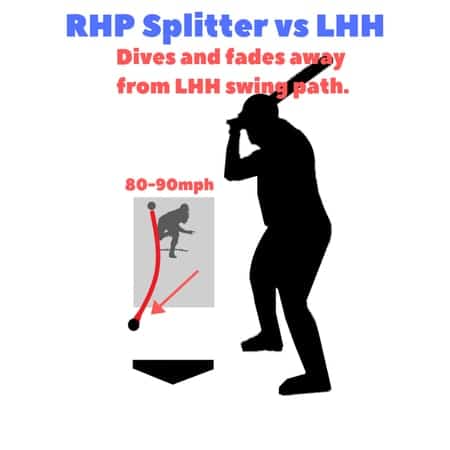
Breaking Balls
A breaking ball is a pitch that has significant spin-created movement to it. Although there are other types of baseball pitches that have movement as well (albeit not as much), these pitches designated as “breaking balls” are designed and used specifically because of their unique and dramatic movement. Below is an illustration of the four main types of breaking balls in baseball:
- Curveball
- Slider
- Slurve
- Screwball.
**It is important to remember that location does not matter. For example, if a slider is thrown high or low or outside or inside, it is still a slider. These illustrations are intended to show movement.**
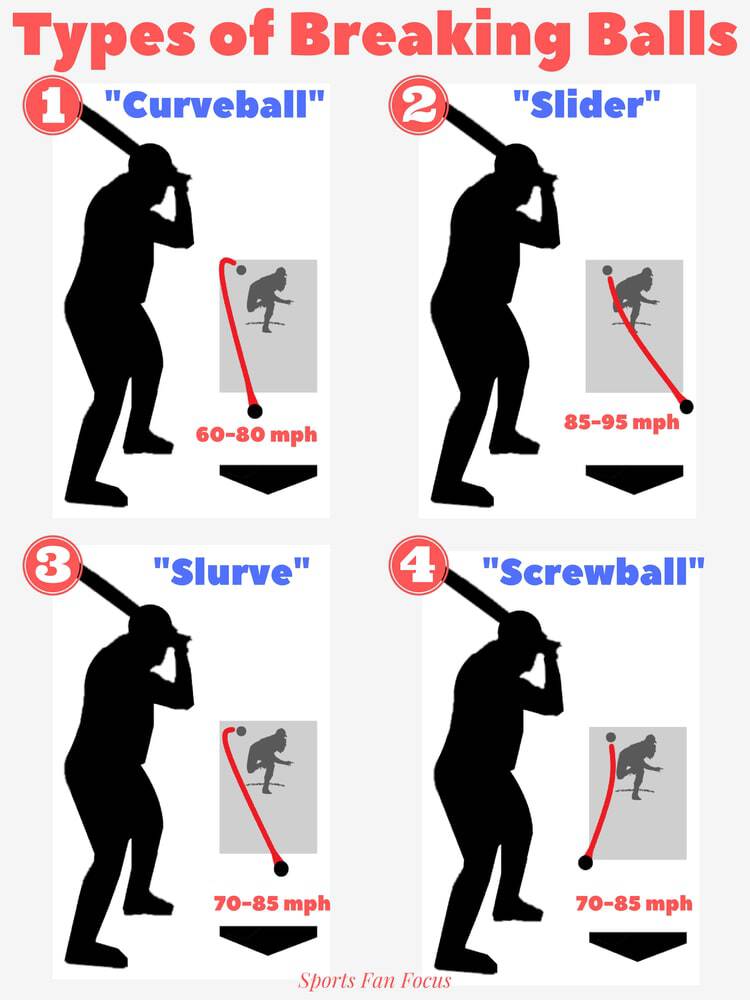
Out of the four breaking balls illustrated above, only the curveball and slider have a prominent role in Major League Baseball. The slurve (a hybrid between a slider and a curveball) is used by only a small amount of professional pitchers (not nearly as common as a curveball or slider). The screwball is nearly non-existent in modern day professional baseball for reasons we will discuss in the screwball section below.
Curveball
- Velocity: 60-80 mph
- Movement: Deep diving action as it nears the plate
- Video: Click here for examples of MLB’s best curveballs.
- Grip: Click here for how professional pitchers grip a curveball.
The curveball is used a lot in professional baseball. The grip combined with a sharp, downward release of the ball causes significant forward spin on the baseball. That forward spin causes the baseball to break downward sharply as it nears the plate.
Curveballs are very effective in Major League Baseball because not only do they have drastic movement down in the zone, but they are also thrown at a much slower velocity than fastballs, which causes problems for hitters trying to time baseball pitches.
The actual speed of a curveball will vary significantly in professional baseball. Some pitchers may even throw occasional curveballs slower than 60mph. Most MLB curveballs fall in the 75-80mph range (some may push up near 85mph on occasion).
Curveballs are considered a strikeout pitch since the depth of the break causes this pitch to miss a lot of bats. This means pitchers will often use a pitch like this when they have two strikes on a hitter, and a swing and a miss will then result in a strikeout.
Some curveballs are referred to as “12 to 6” curveballs because of the significant end over end break it has (as it it was breaking from 12 to 6 on a clock). Curveball is such a popular pitch that it has several nicknames that commentators and players will use when referring to it. Here is my article detailing those nicknames so that you know what commentators and players mean when they use these names.
Hanging Curveball
Sometimes in baseball, you might hear a commentator refer to a pitch as a “hanging curveball”. A hanging curveball is a curveball that does not break properly, and instead just sorta hangs and floats in the air. Here is an illustration of a hanging curveball path vs a normal curveball path:
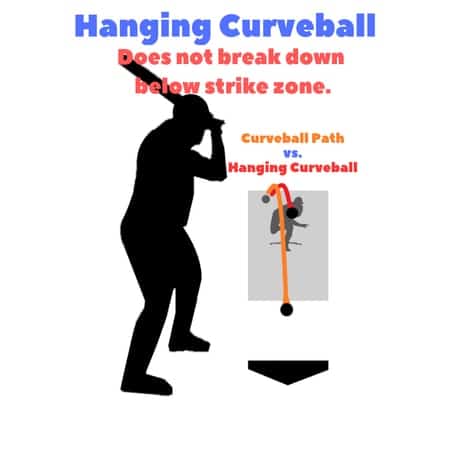
Hanging curveballs happen when a pitcher has a breakdown in grip, release point, or some other form of pitching mechanics. Hanging curveballs get hit very hard in professional baseball because they hang in the strike zone at a slow velocity and are very easy for hitters to square-up and drive.
Slider
- Velocity: 85-95 mph
- Movement: Sharp, glove-side break with sweeping action
- Video: Click here for examples of MLB’s best sliders.
- Grip: Click here for how professional pitchers grip a slider.
Many professional hitters consider a hard-thrown slider to be the most devastating pitch in baseball. When sliders are thrown hard, they combine extreme velocity with sharp, violent breaking action. As you can imagine, matching the barrel of the bat to a pitch like that is incredibly difficult.
Hard sliders break so late that halfway to the plate they look like fastballs. When the hitter fires their hands, they think they’ve got a fastball, but by the time the bat reaches the zone, the late-break occurs an the pitch dives under the bat.
Sliders are so tough to identify and square-up that pitcher’s who have premium sliders feel very confident throwing them as strikes in the zone if needed.
There are multiple planes on which a pitcher may choose to throw a slider. When it is down in a corner of the strike zone, it may have a longer sweeping action to its finish. When the pitcher tucks it in on a corner for a strike, it has a tighter break. Here is an illustration of a couple common paths sliders will take:

Left-handed sliders can be especially difficult to hit due to the plane that many left-handed pitchers throw off of. Lefty sliders can have long horizontal movement along with vertical break.
Horizontal movement in pitching can be dangerous for pitchers by itself (because it spends more time on the same plane as a swinging bat), but when sharp horizontal movement is combined with downward driving action (like what happens with a slider), it becomes very difficult for hitters to square-up, moving almost like the path of a frisbee.
Here is an idea of what many premium left-handed sliders look like:

As you can imagine, these types of sliders are very difficult for left-handed hitters to hit. When hitters see the ball start behind them, their tendency is to let their front hip fly open.
When the front side flies open for a hitter, the swing-path is pulled that way with it, which means the swing path is no longer in the strike zone. Keeping the front side in is very important for hitters, and sweeping sliders make it difficult to fight the natural reaction of moving the front hip when it looks like the baseball is coming straight for it.
Hanging Slider
Hanging sliders occur just like hanging curveballs do: the pitcher had a breakdown in grip, release point, or some other form of his pitching mechanics which caused the ball to float through the strike zone instead of breaking down.
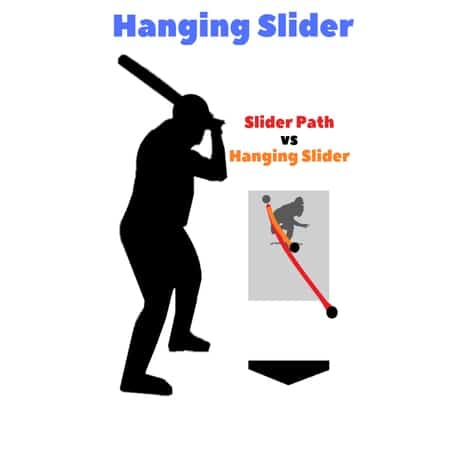
Just like hanging curveballs, hanging sliders are perfect for hitters to square-up and drive because they are at a comfortable speed (slower than a fastball) and float through the middle of the strike zone.
Slider vs Curveball
Although both a slider and a curveball are considered breaking balls, there are important differences that separate these baseball pitches from one another, for example:
- Velocity – Sliders are thrown much harder than curveballs. Sliders usually are thrown around 85-95mph and curveballs are thrown 75-90 mph.
- Path – The pitch path of a curveball is much loopier than a slider due to the lack of velocity
- Break – Curveballs generally break straight down (like 12 to 6 on a clock), or maybe slightly to the glove side (like 12 to 5 on a clock for a RHP). Sliders have more defined glove-side break (more like an 11 to 4 break). The break of a slider is more like the curve of a frisbee. Curveballs will show their break earlier in the flight of the pitch than a slider will.
- Deception – Sliders are more deceptive than curveballs because they break later than curveballs. This doesn’t mean that curveballs aren’t as useful as sliders. Both are very difficult to hit when thrown properly. Curveballs are just easier to identify out of the hand because of how early the movement starts in the flight of the pitch. Some pitchers like to throw a harder curveball than other pitchers (85-90mph). Some hard curveballs have late break and can look like a fastball out of the hand. But many curveballs are slower and have a loopier break than a slider.
Here is the path of a curveball vs the path of a slider:
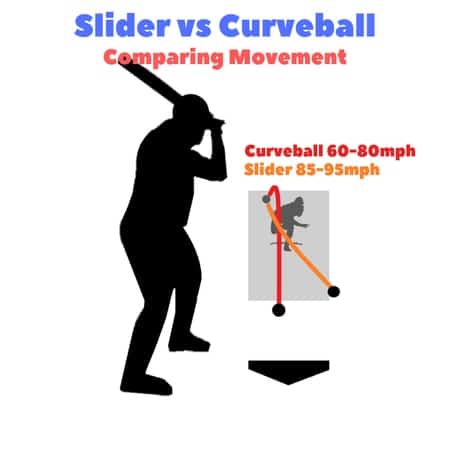
Both curveballs and sliders are effective baseball pitches that consistently miss bats. Because both pitches have a lot of movement, some professional pitchers struggle with locating them consistently.
Locating breaking balls consistently is one of the most important factors that define elite professional pitchers. If they can locate a breaking ball where they want, they can trust that pitch much more, and even use it when they are behind in the count and need to throw a strike (because they can trust they can locate it for a quality strike on a corner or down in the zone).
There are several factors that help a pitcher determine if they should throw a slider or a curveball (or both):
- Organizational Philosophy – Some MLB organizations believe in one pitch over the other. This may be due to personal preference of those in charge or due to injury concerns. This will only apply to young pitchers in the minor leagues. Organizations will not ask big-league pitchers to change their pitch mix to fit an organizational philosophy. But they may use a philosophy in the lower levels of the minors to mold and develop young pitchers.
- Comfort – Some pitchers are more comfortable gripping, releasing and locating one pitch over the other.
- Effectiveness – A pitcher may get more swings and misses with one pitch over the other, so choose to use it more often.
- Pitch Mix – A pitcher may choose one pitch over the other because it blends more effectively with the other pitches that he throws.
Slider vs Cutter
The slider may be classified as a breaking ball and the cutter might be classified as a fastball, but the two pitches are very similar. They both are thrown 85-95 mph and have late glove-side break. A hard slider can be almost identical to a cutter.
In general however, the slider offers more movement (due to its different grip and wrist release angle). When a pitcher throws a slider with max velocity, the movement is so tight it is very similar to a cutter. But a pitcher can take a few mph off a slider and make its movement more dramatic.
The cutter’s movement is minimal in comparison to a slider. Although their velocity can be similar and they break to the same side, the depth of break is bigger for a slider.
Slurve
- Velocity: 70-85 mph
- Movement: 11 to 5 break, mix between curve and slider
- Video: Click here for examples of MLB’s best slurves.
- Grip: Click here for how professional pitchers grip a slurve.
Although most Major League Baseball pitchers throw either a curveball or a slider, some throw a hybrid of the two, known as the “slurve”. The slurve has:
- More vertical break than a slider
- Less velocity than a slider
- More horizontal break than a curve
- More velocity than a curve
Here is a look at the slurve in comparison to the break of a slider and a curveball:
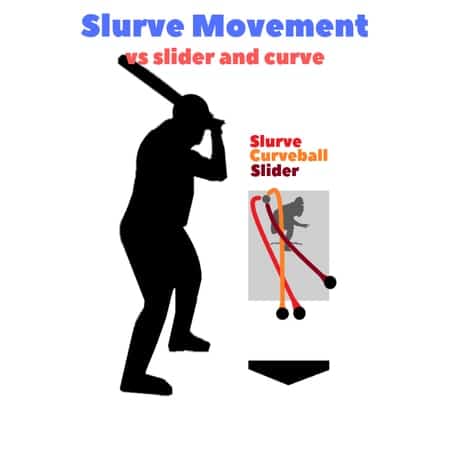
Slurve is a very effective pitch just like a curveball and a slider. It is less popular in Major League Baseball just because most pitchers and organizations focus on either the slider or the curveball.
In fact, many pitches that professional pitchers may classify as a “curveball” or a “slider”, may in fact be more of a slurve (meaning the movement is in between the curve and slider), but the pitcher just chooses still to call it either a curveball or a slider. The name is meaningless. What really matters is whether or not it misses bats and induces weak contact consistently.
Screwball
- Velocity: 70-85 mph
- Movement: Arm-side vertical break
- Video: Click here for examples of screwballs in a game.
- Grip: Click here for how pitchers grip a screwball.
The screwball is a dying pitch in the professional ranks. Its effectiveness and importance has been called into question in modern baseball along with serious concerns about the stress it puts on a pitcher’s arm.
It’s different than other breaking balls because it moves towards the pitcher’s arm-side. All other breaking balls move toward the pitcher’s glove side (with the exception of some curveballs that have a true vertical drop).
For pitchers looking to get off-speed pitches to move back towards the arm side, most have moved on from the screwball and instead use change-ups and split-finger fastballs which both can get arm-side fade when they drop (and put much less stress on a pitching arm in the case of a changeup).
Off-Speed Pitches
Off-speed pitches are baseball pitches that are designed to throw off the timing of hitters. Pitchers use change-ups to protect their fastballs (and make those fastballs more effective).
When a change-up is thrown correctly, to the hitter’s eyes it looks like a fastball. The arm motion and release point and initial trajectory are all the same. This causes the hitter to fire their swing on the timing of a 90-100 mph fastball. But the change-up grip causes it to be about 10 mph slower than a fastball.
This 10 mph separation between the fastball and change-up causes the hitter to get the bat head too far out in front of the pitch, which results in a swing and a miss or inconsequential contact.
Besides change-ups, there are also forkballs and knuckleballs that will be used occasionally at the professional level. These pitches are quite rare, but do exist. Knuckleballs are often used as a near stand-alone pitch, which we will discuss in greater detail below. Hear is a look at the movement of the four main off-speed pitches:
- Changeup
- Circle Changeup
- Forkball
- Knuckleball
**Again, location is does not matter, meaning a change-up thrown high, low, outside, or inside is still a change-up. The illustrations are intended to communicate movement and velocity.**
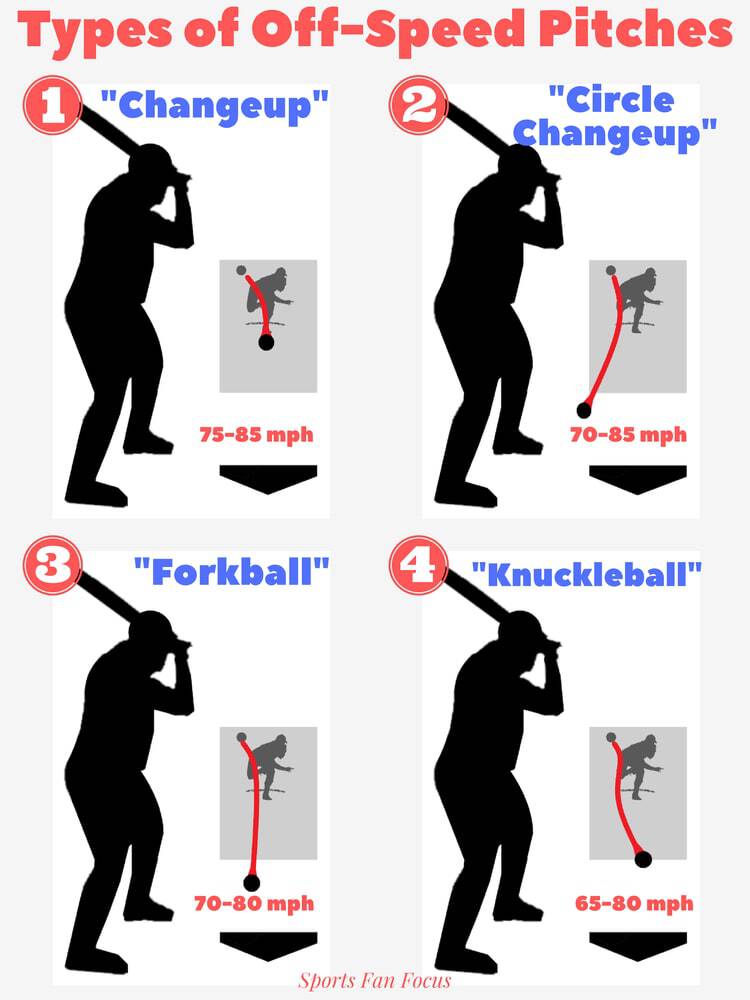
Changeup and Circle Changeup
- Velocity: 75-85 mph (~10 mph less than a pitcher’s fastball)
- Movement: Vertical drop with possible arm-side fade.
- Video: Click here for examples of changeups in a game.
- Grip: Click here for how pitchers grip different changeups.
The standard version of a changeup, also called a “straight change”, is a pitch that relies almost exclusively on velocity to trick hitters. It can be thrown with multiple types of grips, but regardless of grip, it is released from the pitcher’s hand in a way that gives it a straight trajectory towards the plate, but is about 10 mph slower than the fastball.
The circle changeup is generally different. Although some pitchers will still use a circle changeup grip and release it in a way that gets straight action, most prefer to pull the release in a way that causes the pitch to get heavy arm-side fade along with significant vertical drop.
Changeups are intended to look identical to fastballs in arm motion, release point, and initial trajectory, but they take a click longer to get to home plate. This causes hitters to swing out in front of the baseball because their eyes tell them they have a fastball.
Pitchers who get heavy arm-side fade on their changeup also like to use it as a weapon to keep away from the swing path of opposite-handed hitters.
For example, a right-handed pitcher who throws a circle-changeup that gets heavy arm-side fade, can use that pitch against left-handed hitters to allow the movement of the pitch to naturally fade away from the hitter’s swing path. Here is an example of what that might look like:
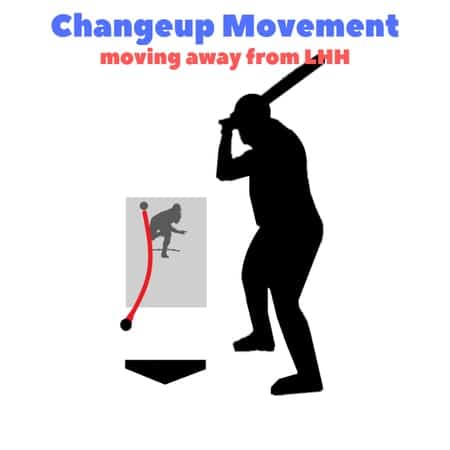
Changeups can be effective strikeout baseball pitches because hitters will be so far out in front with their swing that they commonly will miss the ball entirely.
Pitchers will also rely on a changeup to keep hitters “off their fastball”. This means that a pitcher will use the deception of a changeup to make hitters begin to second-guess whether that pitch coming towards them is actually the changeup or the fastball (remember, if a pitcher is executing them correctly, they will look identical in arm motion and release).
Forkball
- Velocity: 70-80 mph
- Movement: Significant vertical drop near plate.
- Video: Click here for an example of a forkball in a game.
- Grip: Click here for how pitchers grip a forkball.
The forkball, when thrown correctly, is a very difficult pitch for batters to hit because of the extreme vertical drop it has as it nears the plate. The forkball is thrown with a split-fingered grip just like the splitter, except for the forkball grip does not use the seams like a splitter does (and it sits deeper between the fingers).
Many people refer to the forkball as a “slip” pitch or a “feel” pitch because the ball essentially slides out of the pitcher’s hand due to the unique split-fingered seamless grip. As you can imagine, it can be quite difficult to consistently control a pitch that simply slips out of the hand. This causes many pitcher to refrain from using the forkball.
There is also significant concern in the baseball industry about the strain that forkballs can put on a pitcher’s arm. Because of this, young professional pitchers will usually opt for other types of off-speed pitchers.
A player may move to a forkball later in their career if the other off-speed pitchers they use start to fade in effectiveness. Early in a career, most pitchers would rather opt with changeups which carry much less long-term injury risk.
Because the forkball is a pitch that slips out from in between a pitcher’s fingers, sometimes on a clean release it actually flies through the air with no rotation on the baseball (very similar to a knuckleball). When this happens, the ball may actually dance back and forth on the way to the plate as the wind pulls it around.
Forkball vs Splitter
The forkball and the split-fingered fastball (splitter) have very similar split-fingered grips, but their are some unique differences that cause these pitches to be quite different.
The forkball is gripped as far back between the fingers as possible, and the fingers are not touching any seams. This allows the pitch to slide/slip out between the fingers and have little to no rotation on the baseball as it flies toward home plate.
The splitter is not buried as deep between the two split fingers on the grip. Also, the fingers touch the seams of the baseball. These two things allow the splitter to be controlled more effectively than the forkball.
When the splitter is released from the pitcher’s hand, because the split-fingered grip used the laces, the ball spins and looks initially like a “2-seam” fastball. The forkball does not come out of the hand with rotation, and does not look like a fastball to the hitter.
Generally, the splitter is classified as a fastball and the forkball is classified as an off-speed pitch. The splitter can have enough speed variation from traditional fastballs that some pitchers may choose to use the splitter (even though classified as a fastball) as their off-speed pitch.
Both of these baseball pitches can put significant strain on an arm and are to be avoided by youth players and are often even avoided by young professionals.
Knuckleball
- Velocity: 65-80 mph
- Movement: Side-to-side movement from drag crisis
- Video: Click here for examples of knuckleballs in MLB games.
- Grip: Click here for how professional pitchers grip a forkball.
The knuckleball is probably the most unique pitch in professional baseball. It is used by only a few Major League pitchers, not because it isn’t effective, but because it is very hard to master.
The difficulty in mastering this pitch comes from the fact that the pitcher does not grip any seams and attempts to release the baseball in a way that causes it to fly towards home plate with no rotation. As you can imagine this is very difficult since the natural release of a baseball from a hand causes spin as the ball rolls off the fingertips.
Many pitchers spend years attempting to master this pitch. If mastered, the knuckleball is a pitch that is thrown almost exclusively, and has a pitch mix that usually just only consists additionally of an average fastball that the pitcher will mix in occasionally to keep the hitters honest.
When this pitch is thrown effectively the ball will actually dance back and forth as it nears the plate due to what experts call “drag crisis”, which is in reference to the wake that the ball leaves as it flies through the air (take a deep dive into the physics and hydrodynamics of a knuckleball in this Inside Science article).
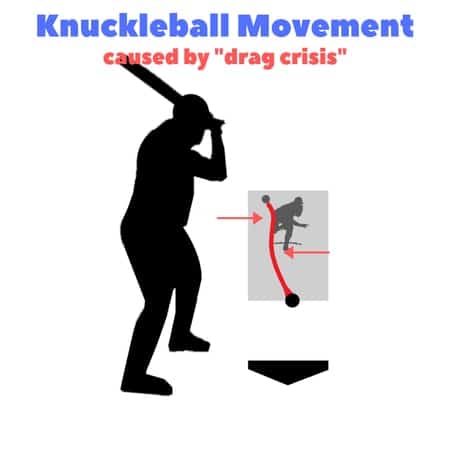
The “drag crisis” effect is not consistent across all baseball pitches, meaning that the movement on one knuckleball may very well be different than the movement on the next knuckleball. This unpredictability makes it very difficult for hitters to time and to square-up.
The knuckleball also puts very little stress on a pitcher’s arm, and can allow pitchers to pitch into their 40’s. Many knuckleball pitchers prefer to throw in open-air stadiums because they feel like the wind will also give them extra movement on their pitches.
Baseball Pitches: How Pros Use Them
In the sections above we detailed uses for each specific pitch, but how does it all fit together? How do professional pitchers choose pitches and sequence them?
First of all, there are three different types of big-league pitchers:
- Starters – the pitchers who start the game and traditionally throw 90-110 pitches if possible
- Long-relief – Bullpen pitchers who have the arm durability to throw multiple innings
- Short-relief – Bullpen “power” pitchers who maximize velocity and have endurance to throw usually only one inning.
**If you want to take a deeper dive into understanding MLB pitch limits and whether or not teams institute them, read our article here that discusses this in depth.**
The specific pitch mix that a pitcher uses will be influenced by what type of pitcher they are: starter, long-relief pitcher, or short-relief pitcher. Starters need to have a minimum of 3 to 4 reliable pitches just so that they have enough pitches to give hitters several looks throughout the game.
Starters will throw approximately 100 pitches in a game, which means they will face some batters 3 or 4 times. It would be unwise to throw the same pitch sequence to the same hitter 3 or 4 different times because the hitter would adjust. Having four baseball pitches to throw allows a starter to save one of those pitches and start to mix it in later in the game to give hitters a new look each time through the order.
Short-relief bullpen pitchers will never face a hitter twice in the same game, so they do not need a deep mix of pitches . Many relief pitchers throw only two pitches, although some converted starters who moved to the bullpen later in their career may have several pitches they throw even in short-relief. A long-relief pitcher usually is a failed former starter and will have 3 to 4 pitches to use since he may face a hitter more than once.
A pitcher’s plan is strongly influenced not only by how own strengths and weaknesses but also the strengths and weaknesses of the hitter. Other factors such as ballpark dimensions, game situation, and defensive alignment will also play a factor in how a pitcher attacks a hitter.
How a Professional Pitcher Uses Fastballs
Disclaimer: All pitchers are unique and put their own fingerprint on pitching. This is a general description of how a typical big-league pitcher may use his pitches.
Here are the main scenarios where big-league pitchers typically like to rely on a fastball:
- Early in the count – A pitcher will often use the fastball early in an at-bat because (as we discussed earlier in the fastball section) the fastball is the easiest pitch to control. Getting ahead of hitters and throwing early strikes early in an at-bat is important to the success of a pitcher. If a pitcher gets ahead, they can then use their strikeout pitches to induce swings at pitches out of the strike zone.
- Setting Up Another Pitch – A pitcher may use a fastball in the middle of an at-bat to setup his next pitch. For example, setting up a changeup by throwing a hard fastball right before it can be effective because the drastic change in speed from pitch to pitch bothers the hitter.
- Strikeout – Some pitchers with premium fastballs will regularly use their fastball as a put-away pitch to finish off a hitter. Only premium fastballs will be relied on heavily in this manner.
How a Professional Pitcher Uses Breaking Balls
Here are the main scenarios where big-league pitchers typically like to rely on a breaking ball:
- Ahead in the Count – If a pitcher is ahead in the count, for example 1 ball 2 strikes, they will use their breaking ball (slider/curve) to see if the movement of the pitch can get a hitter to swing at a pitch he has no chance of hitting. This is why breaking balls are often referred to as “strikeout pitches”. Because the pitcher is ahead in the count, he has the opportunity to waste a pitch or two throwing pitches outside the strike zone hoping to get a chase.
- After a Fastball – For example, a pitcher with a hard slider may use that slider right after he threw the fastball, because the slider will look a lot like the fastball when it is half way to the plate. Because the hitter just saw the fastball, the pitcher may induce a fastball swing from the hitter on a slider that breaks away from the bat.
- Early in the Count – The elite pitchers can control their breaking balls effectively also, so they won’t hesitate to throw a breaking ball for strike one. No pitcher wants to become predictable, so even pitchers who don’t locate their breaking balls consistently will still start some at-bats with breaking balls to keep the hitters honest.
How a Professional Pitcher Uses Off-Speed Pitches
Here are the main scenarios where big-league pitchers typically like to rely on an off-speed pitch:
- After or Before a Fastball – Mixing a changeup with a fastball (with 10-13 mph difference) can be very effective for a pitcher.
- In a Fastball Count – In baseball, when a pitcher falls behind in the count, for example 3 balls 1 strike, they will often go to the fastball because it is easiest to locate (and they don’t want to issue a walk). These counts are known as “fastball counts” because hitters know that a pitcher may possibly use that fastball to get back into the count. There are times where a pitcher will flip this, and knowing the hitter is thinking fastball, use a changeup (which comes out of the hand like a fastball) to trick the hitter.
- In a Big At-Bat – If there is a big at-bat in a game (for example bases loaded), a pitcher may start an at-bat with a changeup because the hitter will be anxiously looking for a fastball to drive. The changeup will often catch the hitter being too aggressive.
What Types of Pitches Induce Double Plays?
Let’s say for example a pitcher has runners on first and third with one out. This becomes a big spot to induce an inning-ending double play. There are certain baseball pitches that are used in spots like this to hopefully induce a ground-ball double play:
- Split-Fingered Fastball or Forkball – Both of these pitches have late vertical drop that can cause the ball to drop under the bat and cause the hitter to hit the top-half of the baseball.
- Fastball away to pull hitter – If the batter is a notorious pull hitter, a pitcher may use a hard fastball away to see if he can catch the hitter trying to pull that pitch (which is very hard to pull). Usually if an outside fastball is pulled it results in a chopping ground ball to an infielder on the pull side.
- Slider/Curve/Slurve – Because these pitches have movement, they also can result in ground balls. The slider can be particurlarly effective if the hitter thinks its a fastball. A fastball swing on a slider usually results in a swing and miss or a ground ball.
How To Identify Baseball Pitches On TV
If you are watching a game on TV and are hoping to identify what pitches are being thrown, here are a few tips to help you out:
- Watch Movement and Velocity: Combine the velocity with the movement to help identify the pitch (velocity should be on TV score display). For example, a 92 mph pitch that moves toward the pitchers arm-side is likely a 2-seam fastball. A 90 mph pitch that moves toward the pitcher’s glove-side is usually a slider or cutter. Review the movements and velocities detailed in the sections above, and use them to practice identifying pitches.
- Know the Pitcher: Most television broadcasters will tell you, at some point, what pitches a pitcher throws. This will give you a smaller list to match with movement and velocity. If a pitcher throws a fastball, curve and changeup, there will be some obvious tells for you to identify what pitch was thrown. For example, if a pitch was 91 mph, that was obviously the fastball because the other pitches won’t be moving that fast. You can also use a website like Fangraphs to look at what pitches a pitcher throws.
- Look for Catcher’s Signal: Yes, just let the catcher tell you. If you look closely you might be able to see their signal. There may be some situations where a catcher and pitcher change their signs, but generally one finger down means a fastball, two fingers down means curve, three down means slider, and four down means a changeup. You may also occasionally see them tap an outer or inner thigh. So if you see a catcher put down two fingers then tap the outer thigh, he’s asking for a slider away. If you see him put down a one and tap the inner thigh, he’s asking for a fastball in. Not all catchers tap for direction and instead just align their bodies as a target where they want the ball thrown. Also, some catchers may angle the fingers in the direction that they want the pitch. So, for a fastball away, a catcher may put one finger down pointed towards his (the catcher’s) outside leg.
FAQ About Types of Baseball Pitches
What’s The Hardest Pitch To Hit In Baseball?
This is relative to each pitcher and hitter, but commonly a hard slider is considered to be the hardest pitch to handle. When a knuckleball is working (meaning it is moving a lot), it can be extremely difficult to hit, but it is much rarer than a hard slider.
What’s The Easiest Pitch To Hit In Baseball?
Average fastballs that don’t have elite velocity are like batting practice for big-league hitters. Obviously mistake pitches (like hanging curveballs etc) are perfect for hitters as well. Many hitters prefer a 90-92 mph fastball waist high in the middle of the plate or maybe slight in towards the hands. In Major League Baseball a pitch like this is often referred to as a 92-mph “3 ball”, due to its location on the plate horizontally.
What is a Sweeping Curve in Baseball?
A sweeping curveball is another name used for a breaking ball that is a mix between a slider and a curveball. Occasionally, a pitcher may classify his breaking ball as a “sweeping curve”, but that is quite rare and most pitchers identify their breaking balls as either a curveball, slider, or slurve.
What is a ‘Sinker Slider’ Pitcher in Baseball?
A sinker-slider pitcher is a pitcher who relies heavily or even exclusively on a sinker (2 seam fastball) and a slider. Many times these pitchers will also throw a changeup to offer an off-speed pitch.
The sinker-slider combination is particularly effective because the 2-seam fastball (which is the “sinker”) moves arm-side while the slider moves glove-side. This gives the pitcher movement both directions at almost identical velocity, which can be very difficult for a hitter to predict.
